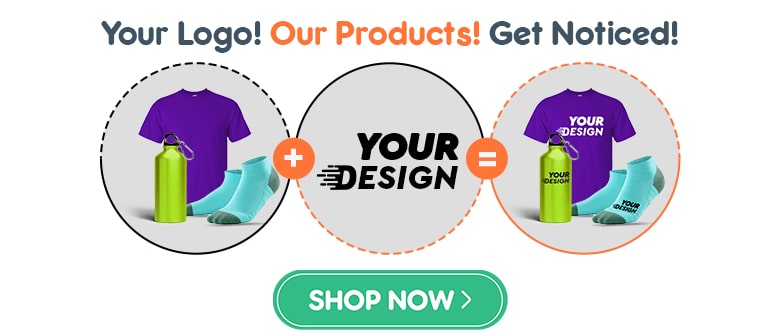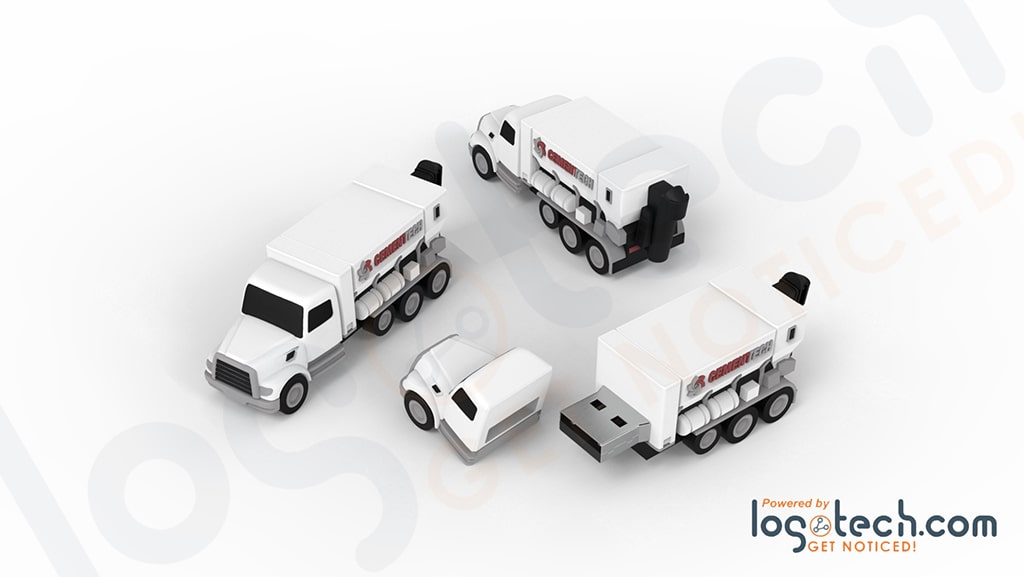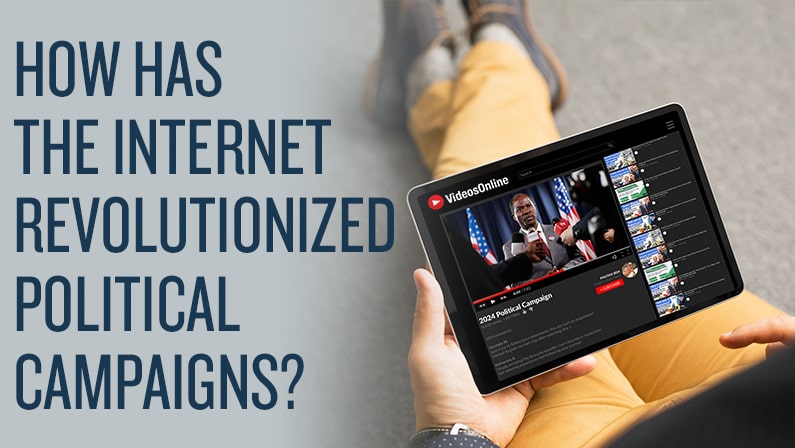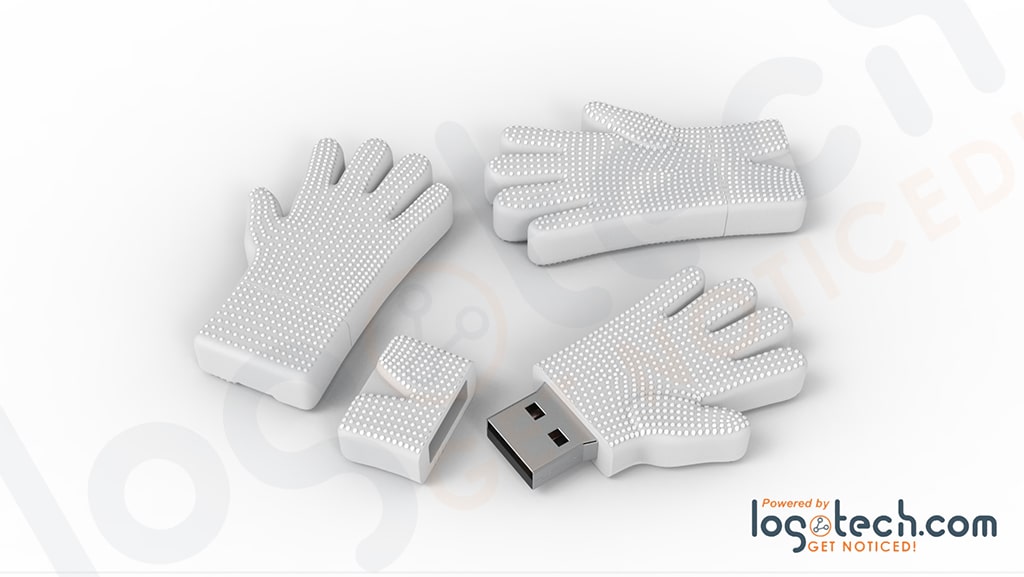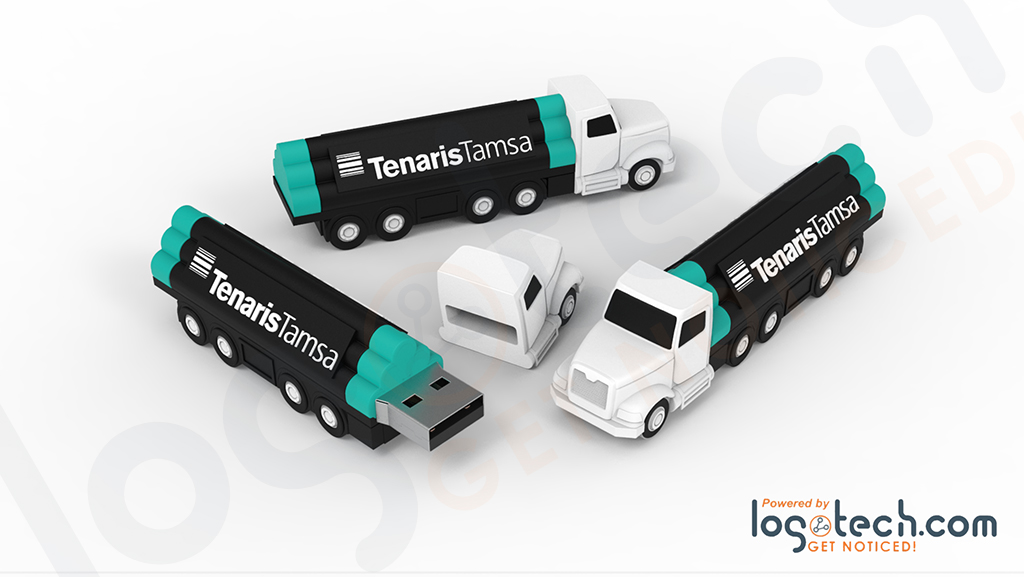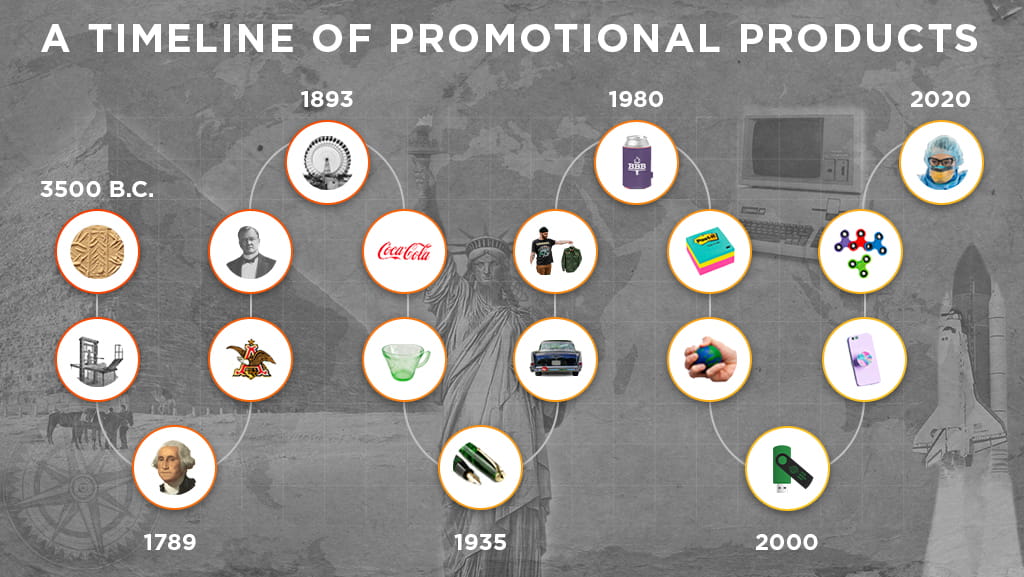
History of Promotional Products
What Is the History of Promotional Products?
Take a look around your home or office desk. How many products do you have that were a promotional gift? You might have drinking glasses you bought at a burger chain or imprinted promotional t-shirts you were given as a thank you for volunteering. Did you receive a USB drive from your mortgage title company? Your mobile provider may have given you a car charger with its logo.
These are just a few examples of the promotional items companies give away nowadays. Why are promotional items so popular? Why do so many companies use giveaways printed with their logo to advertise the company or organization?
As the Father of Promotional Products, Jasper Meek, said (paraphrased): "Give a person something they need, and they will be grateful to you."
That is why giveaways -- a gift with purchase or just a 'thank you' for being a customer -- imprinted with a logo are a powerful form of advertising. Customers love getting something for free they can use in their everyday lives.
So, who came up with the idea of putting logos on t-shirts, glasses, pens, and book bags? Keep reading our history of promotional products to find out!
What was the first branded logo?
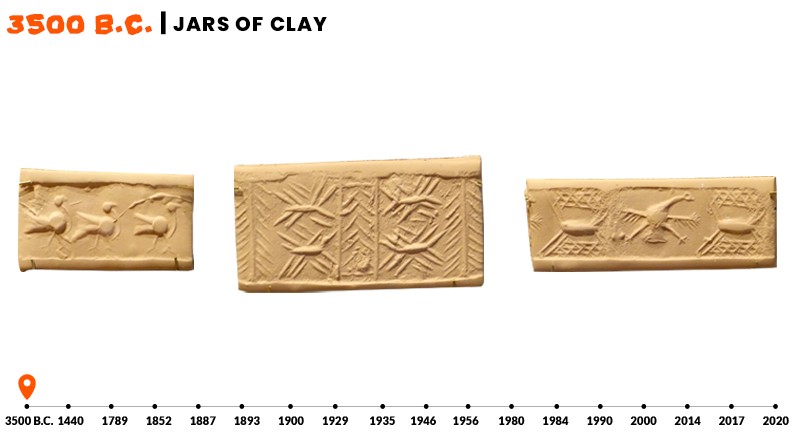
In Mesopotamia and other ancient Near and Middle East cultures, carved stone cylinder seals were rolled in clay to create an imprint. That impression -- a brand of sorts -- was used on packaging including jars, boxes, sacks, and baskets to identify the trade goods inside. The seal could also indicate who owned, made, or grew the merchandise. These labels were among the first forms of writing and printed goods, according to historians.
The imprinted clay tablets, as well as stamp seals and signet rings used with sealing wax, are also the first way merchants could brand goods or show ownership using images. Archeologists today are still determining from those imprints who, and where, those promotional seals came from.
How did printing change the world?
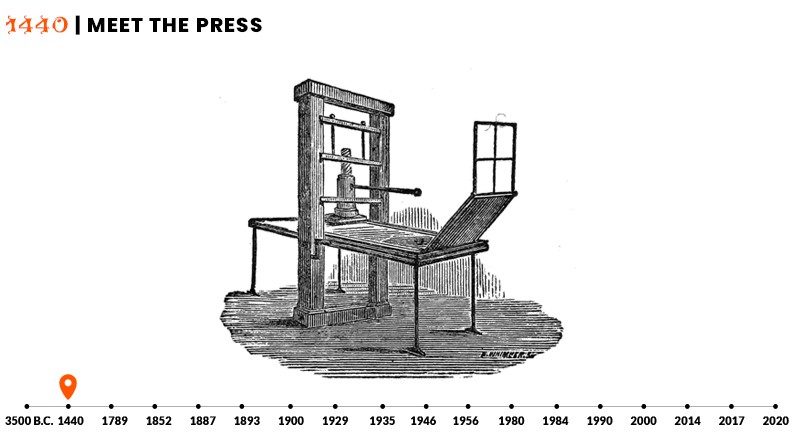
The Gutenberg Printing Press meant instead of books being lettered by hand -- a process that could take months or years -- they could be mass-produced. It led to an increase in literacy among commoners. Bookmarks were soon needed to note where a reader left off.
The printing press and later improvements with movable type made it possible to print newspapers and other periodicals, pamphlets, print advertising, and printed business cards. Ideas could be shared across continents and oceans.
The printing press is also tied closely to the Protestant Reformation. In 1517, Martin Luther used a press in Wittenberg, Germany, to re-create his 95 Theses for wider distribution. Translated from Latin to German and easily reproduced, the monk's writings spread across the country and Europe.
What were the original promotional giveaways in the U.S.?
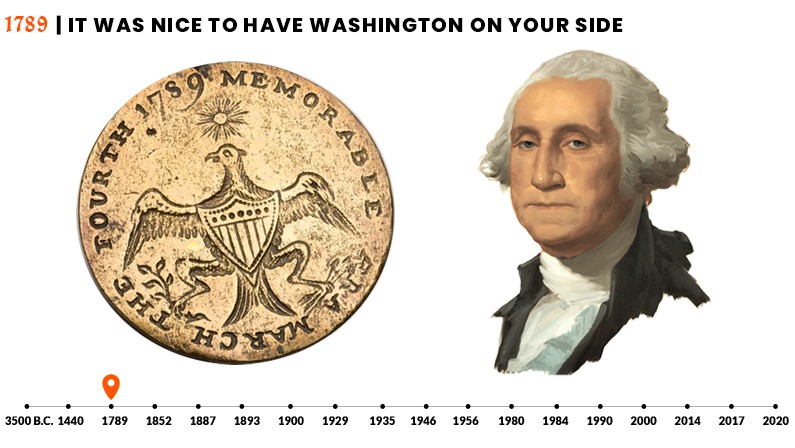
It is believed they were buttons made in honor of George Washington's 1789 inauguration.
Unlike modern day promotional buttons or lapel pins, they were an actual button sewn onto coats. Neither were they free. Enterprising button makers sold these pins rather than give them away.
The buttons caught on. According to mountvernon.org, "patriotic buttons were being sold in time for John Adams' inauguration on 4 March 1797."
Promotional pins and buttons with the candidate's name or slogan are still a huge giveaway for political campaigns, as are hats, banners, and yard signs.
How did brewers promote their brands in America's history?
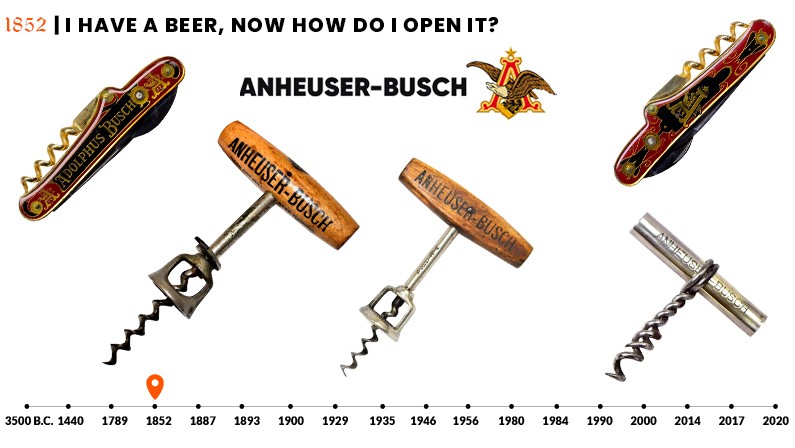
One example is Anheuser-Busch, which opened its doors in 1852 in St. Louis. A few years later, Adolphus Busch started to give away corkscrew knives imprinted with the company logo. Bars that sold their beer were also given other logo imprinted gifts.
The company continues to distribute corkscrews, bottle openers and a host of different branded gifts. Original Anheuser-Busch corkscrews are collector's items and highly prized.
To this day, bars, restaurants, brewers, and distilleries continue to give away bottle openers and corkscrews to promote their brands.
Who invented promotional products as we use them today?
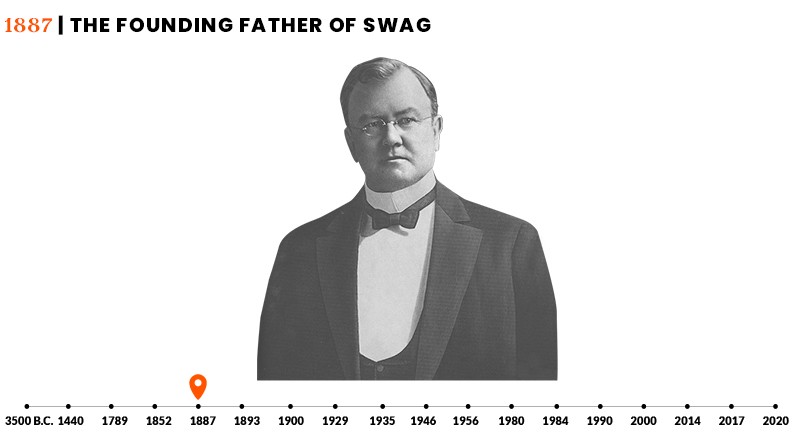
Jasper Meek of Ohio is credited as the father of our modern promotional products -- a gift with purchase. That gift had the business's logo or name printed on it.
According to a July 1948 radio script from WTAM Cleveland, Meek wanted to keep his presses running when not printing his newspaper. He fitted presses to print on burlap, then hired women to sew the burlap into bags. Printed with the paper's name, he gave the bags to schoolchildren.
Soon, the proprietor of a local shoe store asked about the bags. Meek printed bags with the store's name on them, and the store gave away a bag with every shoe sale. The town's schoolchildren now had their own book bags. Meek went on to sell horse blankets, aprons, and just about any fabric he could print on.
Henry Beach, his competition from the town's other paper, started printing on wood. Among other things, Beach began to make yardsticks and rulers, pencils, paint mixers, fly swatters and shoehorns.
The two eventually joined forces but split the business again a few years after that. Either together or as two businesses, Meek and Beach imported products into their Ohio town from around the world -- anything they could imprint with a company logo. Their competing sales staff spread across the U.S. Soon, just about anything could be imprinted, for any company.
What kind of promotional giveaways came from the Chicago Columbian Exposition?
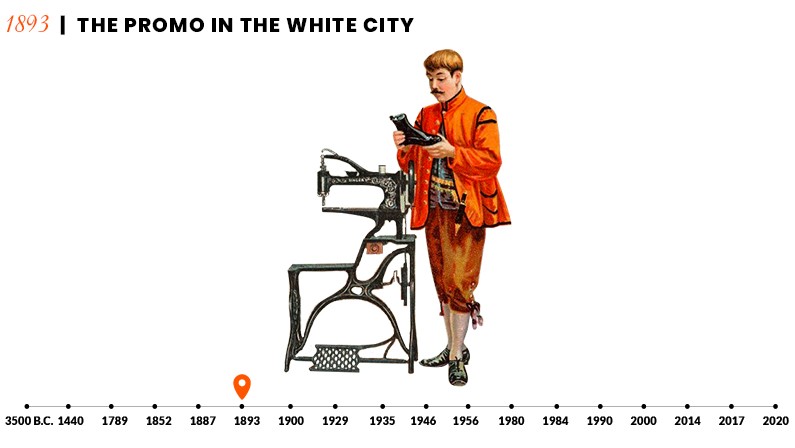
Souvenirs of all kinds were printed for the World Columbia Exposition in Chicago and can still be found in museums today. The exposition is credited for the first promotional keychain. In addition, USPS postcards, commemorative stamps and U.S. Mint collectible coins made for the fair were sold during its run. One of the stars in Chicago's city flag represents that year-long event.
As a World's Fair Exposition, the White City was also a trade show. Manufacturers from around the world displayed their new inventions and products and gave or sold trinkets to the crowds. What variety of promotional giveaway should you pick for your trade shows and expo booths now?
How did Coca-Cola become the brand it is today?
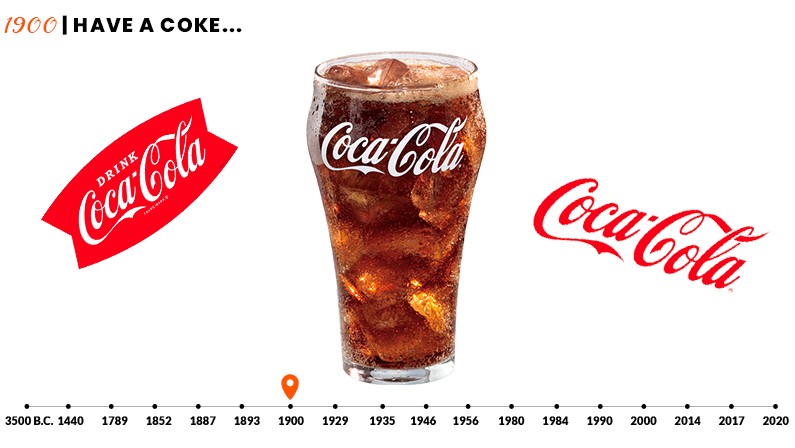
When a soda fountain in Atlanta, Ga., began offering Coca-Cola in 1886, those soda jerks were using whatever glasses they had on hand. However, there was a strict formula of how much syrup to soda water would create the perfect glass of Coke. Too much syrup and the soda fountain lost money. Not enough and the drink did not taste right.
So, Coca-Cola had glasses made for the soda fountains. These straight-sided glasses had a fill line, so the soda makers could see how much syrup they should add. The Coca-Cola logo was chemically etched on the side.
Those glasses were only produced for a few years. The Coke "flare" glass we are used to today was introduced around 1904.
Soon after its original launch, however, the people at Coke were heavily into promotional marketing. The first give away Coca-Cola calendar was produced in 1891. Imprinted serving trays were big for the company in the 1950s. The Coca-Cola logo is now one of the most recognized on the planet.
Do you know when glassware became one of the hottest promotional gifts?
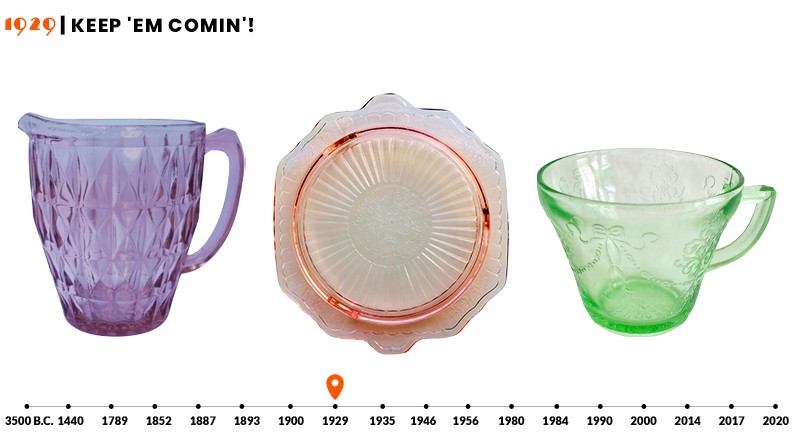
During the Great Depression, business often offered free glassware to customers as a sales enticement. Families could collect matching pieces or entire sets through different stores or even gas stations. Now called Depression glass, it is usually pink, yellow, crystal, or green colored translucent machine-made glassware.
With some businesses giving away glasses and glassware, Kraft saw the benefit of giving households something they could use after the product was consumed. "Swanky Swigs" from the food maker debuted in grocery stores in 1933. These hand-painted glasses could be washed and used as the family drinking glasses for years after.
Then, in about 1938, Libbey Glass manufactured a series of eight glasses featuring Snow White and the Seven Dwarfs. The character glasses were actually packaging containers for peanut butter and mayonnaise.
Fast forward to the 1970s and 1980s when McDonald's, Burger King and other fast-food chains promoted collectible glassware and dishes at their restaurants.
McDonald's offered glasses decorated with the Hamburger, Ronald McDonald and all its characters. Burger King partnered with the movies and sold Star Wars glasses for the theatrical releases in 1977, 1980 and 1983. Drinkware is still one of the top promotional products, including reusable water bottles and glassware.
Who came up with customizing pens?
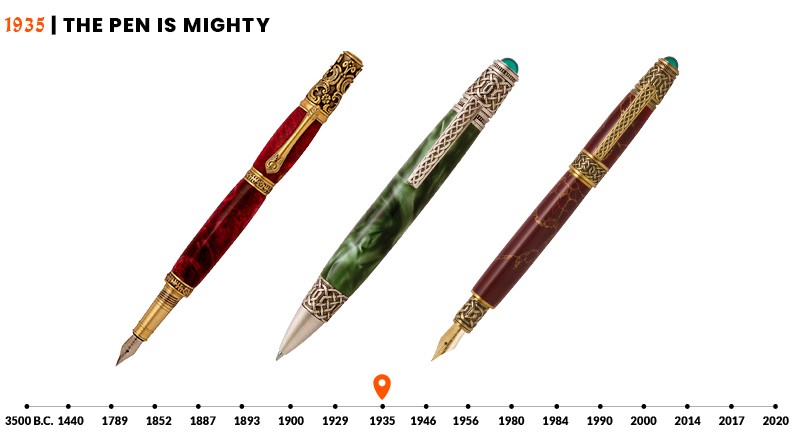
Promotional pens came on the scene when cartoon characters were imprinted on fountain pens. Pepsi-Cola made a pen with a clip shaped like its iconic bottle. After WWII and the advent of readily available plastic, customized pens began to boom.
Companies found that pens, with phone numbers and addresses printed on each, are a great way to promote their business. Promotional pens are still among the top giveaways because they are portable and affordable.
When did bumper stickers start showing up on cars, promoting everything from tourist destinations to political slogans?
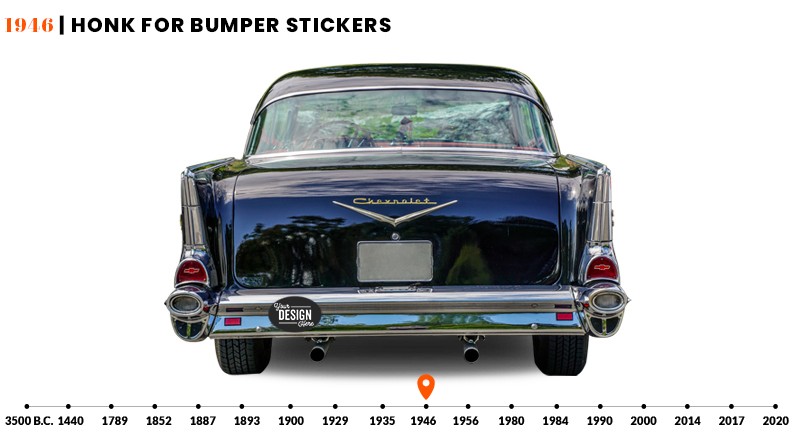
Forrest P. Gill was a printer in Kansas City, putting screen printed ads on spare tire covers. After he was laid off from the printing plant in 1946, Gill opened a screen-printing shop in his basement, according to Johnson County, Mo., historical records.
After WWII, Gill combined Day-Glo paints with self-adhesive paper and started making the first bumper stickers. The company he founded, Gill Studios, still makes stickers, decals -- and of course -- custom bumper stickers. According to the company, decals and stickers are one of the most popular promotional product categories, with sales over $300 million a year.
How many promotional t-shirts do you have?
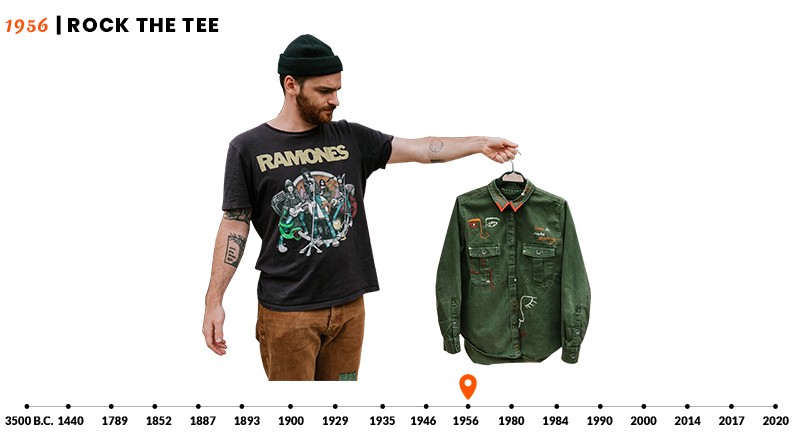
T-shirts have been around since the turn of the century. They picked up steam when the U.S. military made them part of every uniform. The first printed t-shirts include ones worn by three residents of The Emerald City. "Oz" was printed on shirts worn in the 1939 movie.
The first band tee is believed to be a t-shirt printed with an image of Elvis Presley in 1956.
Then in 1960, artist and inventor Michael Vasilantone developed a direct-to-garment, multicolored, rotary silkscreen printing machine. Patented in 1969, the original machine was designed to print team names and logos on bowling shirts. Soon, t-shirts became the canvass of choice.
Roadies, fans, and band merchandisers have had their t-shirts in constant rotation since then. They continue to be a big hit! T-shirts are the most popular promotional apparel today.
Wonder who invented the koozie drink cover?
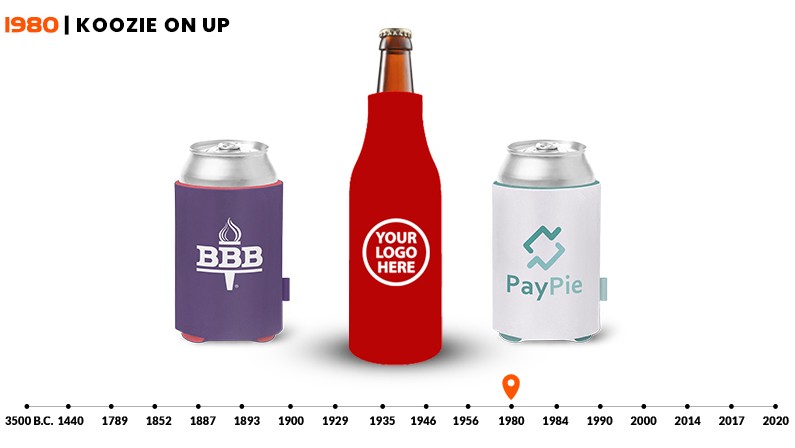
The Radio Cap Corporation trademarked the term Koozie and began selling their first rigid-wall drink cozy. By the 1990s, the soft-sided neoprene styles we are accustomed to came in and other companies began manufacturing beverage sleeves. Koozie has since become a catch-all phrase for drink covers, with many companies making them with imprinted logos. Logotech has koozies for you in multiple styles to match your brand. How many customized Koozies to you own?
Who invented Post-It Notes?
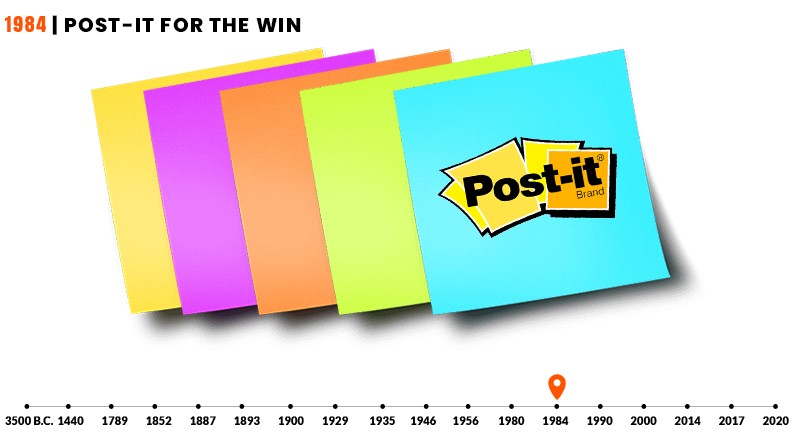
It all began in 1968 when a scientist at 3M discovered an adhesive that would not damage whatever it was applied to. No use for it was obvious, however. Then, in 1974, one of his coworkers put the glue on scraps of paper. He used the notes to mark pages in his church choir hymnal and the first practical application was found.
Still, it was 1980 before the company began selling Post-It Notes commercially. The company began offering Post-It to the promotional products industry in 1984. Now, you can have a logo printed on either blocks or books of sticky notes in many different sizes, shapes, and colors.
Where did the idea for stress balls come from?
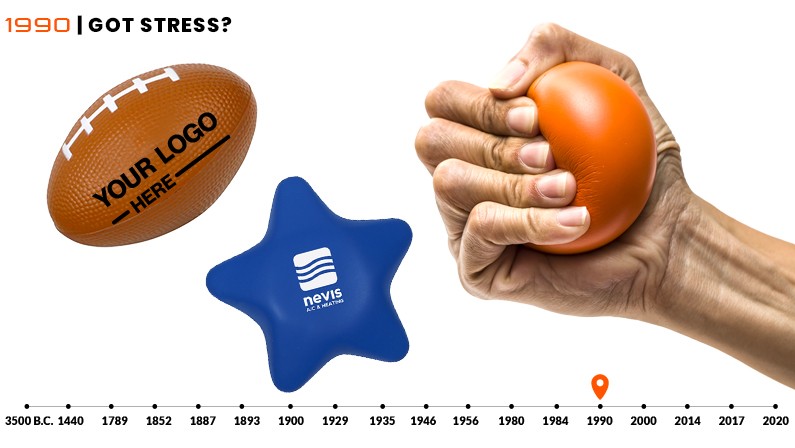
Polyurethane, a substitute for natural rubber, dates to 1937. The military used the material first, and the DuPont Corporation began widely using it in products shortly thereafter.
In 1970, the first Nerf football, also made from polyurethane, was released by Parker Brothers. it was introduced as the "world's first official indoor ball." Nerf introduced a larger version of its football in 1972. The company is known now for its balls, dart guns, and many happy Christmas mornings.
TV writer Alex Carswell is credited with inventing the first stress ball as we think of them today. The story goes that after getting off a frustrating phone call, he threw a marker which hit a framed photo of his mother. The frame shattered and an idea was born. His stress ball was launched at the International Toy Fair in New York, and were sold beginning in 1988, a $24.95 each. The ball made the sound of shattering glass when squeezed.
The stress ball as we see it today -- a round polyurethane ball sized to squeeze in adult hands -- became available as a promotional product in 1990. They could be imprinted with logos and are popular giveaways at trade shows and conventions.
The first shaped stress balls -- or stress relievers since they are not round -- were marked in 1994. Dolphins, seals, cows, and pigs were among the first shapes, but nearly any shape can now be made to match company logos or products.
When did you get your first promotional flash drive?
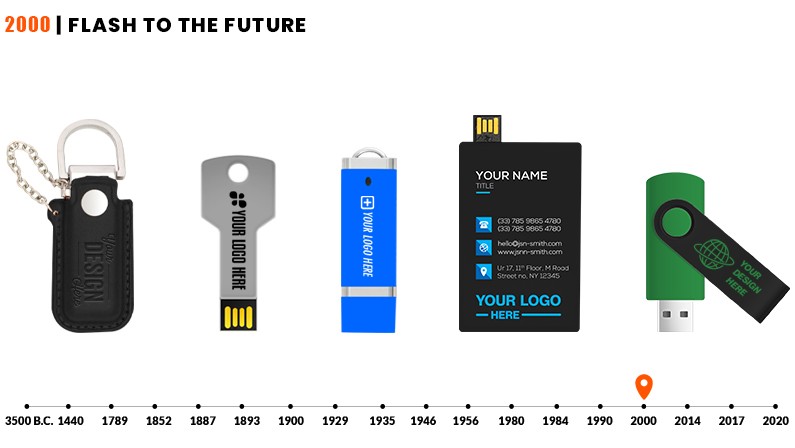
The USB flash drive was introduced and has almost completely replaced the floppy disk and CD for portable data storage. Now, flash drive memory can reach up to 1 TB to store data, photos, video, and music. As a promotional product, companies found they could load thumb drives with information they want clients have at their fingertips.
Musicians embraced flash drive technology early on: the first music album was sold on a thumb drive in 2004. Logotech began selling custom flash drives to customers around the world in 2008.
Logotech's specialty is custom shaped USB flash drives. Most often molded from PVC, they are made to look like nearly anything a client wants, from a 2D recreation of a company logo to a 3D rendering of their premier product, school mascot, or nearly any other shape.
How did PopSockets create the phone grip market?
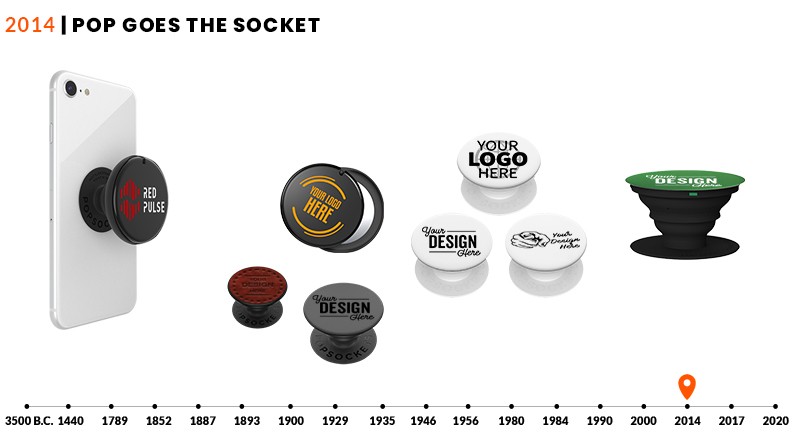
David Barnet, a Colorado college philosophy professor, wanted a way to keep his earbud cord from tangling. He glued buttons on the back of his phone case, but they kept getting in the way. He came up with an accordion concept -- the pop in PopSocket -- and an industry was born.
A successful GoFund Me campaign in 2012 gave him the capital needed to fund manufacturing. After a few false starts, PopSockets LLC began selling units on its website in 2014. In 2018, the company sold 80 million units.
The phone grips help keep mobile devices firmly in hands, prop them up to watch videos, and provide a base for auto mounts.
Through licensing agreements, the company offers PopSockets -- now available in a multitude of specialty materials and uses -- to promotional product retailers. At the same time, the company aggressively went after counterfeit versions to protect its patent and brand name.
PopSockets also launched other phone grips. Phone rings and similar devices allow users to keep a firm grip on their devices, prop them up to watch video or read social media feeds. These are also available for logos and promotional giveaways.
Where can you find a fidget spinner?
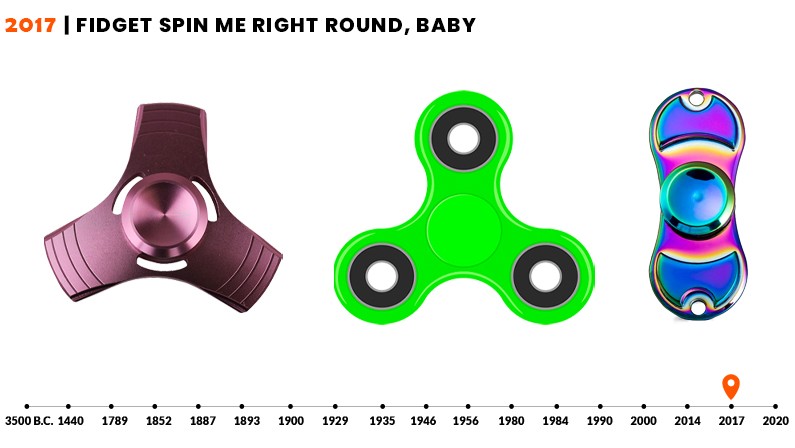
These toys went from startup GoFundMe campaigns to international sensations in 2017. Manufacturers began making the toys in mass. The promotional product industry got on board quickly. Any company can have a fidget spinner with its logo.
So, who gets credit for inventing the fidget spinner? According to many media sources, Catherine Hettinger designed and patented fidget spinners in 1993, but could not find a manufacturing partner to mass produce the toys. Her original patent then expired in 2005.
What she designed was very different from the fidget spinner, however. Hers was more a small flying disc with a domed top.
In 2015, Scott McCoskery designed his Torqbar -- basically a weighted bar with a ball-bearing center. He began selling these through social media. With others seeing his success, entrepreneurs began selling similar devices.
By Spring 2017, fidget spinners could be found in just about every convenience and grocery store checkout lane.
Fidget spinners are still a very popular promotional item. In addition to a fidget spinner imprinted with your logo, customers can pick spinning promotional pens, Backspin PopSocket Grips, and a host of other multi-functional gadgets that will spin, too. Playing with fidget spinners can help relieve stress, just like the stress balls introduced nearly two decades earlier.
How did the promotional product industry help deliver PPE during the pandemic?
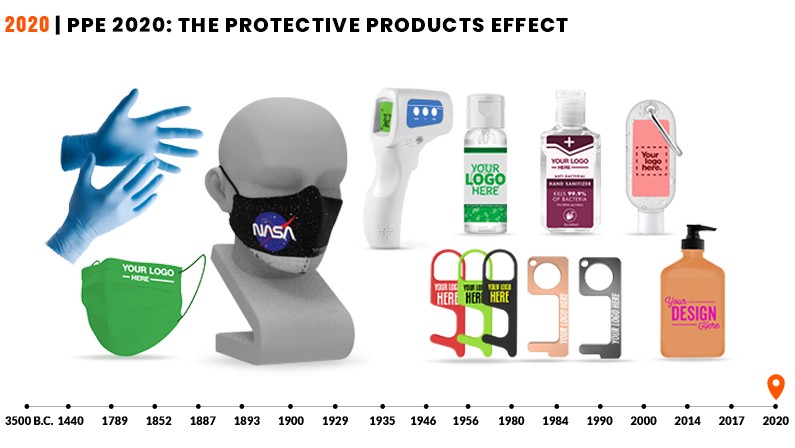
When the World Health Organization certified Covid-19 as a pandemic in early 2020, the promotional products industry jumped in to help stop the spread.
Custom hand sanitizer printed with a logo had been available from the promotional industry for a long time. Supplies of bulk hand sanitizer depleted across the globe as their demand skyrocketed.
Quickly, liquor distilleries across the U.S. shifted production from beverages to high-alcohol content hand sanitizer. Existing manufacturers stepped up and increased production. In a few months, sanitizers -- both blank and those with a logo -- were back in inventory and in consumer hands.
During the COVID-19 pandemic face masks, particularly N95 masks, were hard to find. Again, the promotional product industry stepped up.
T-shirt and other apparel makers pivoted and used their cloth to make washable masks. Manufacturers overseas stepped-up production of the KN95 mask. Promotional product suppliers and distributors became a gateway to get bulk face masks to everyone.
A somewhat newer invention that quickly became poplar were touchless tools. Shaped like a key, touchless tools allow people to open doors or punch numbers into keypads at the grocery store or ATM -- all without touching those surfaces themselves. Touchless tools also helped reduce Covid-19's spread, while helping to spread the name of companies that imprinted these devices with a logo.
What are the newest, cool promotional products?
With every invention designed to make our lives easier, new promotional giveaways are added to the marketplace. Electronics, like smart home speakers, wireless earbuds, Qi wireless chargers and VR headsets, are all available for companies to brand with their logo. When new products come into the promotional marketplace, Logotech will have them for you, too.




